Change Page: 123 > | Showing page 1 of 3, messages 1 to 20 of 54 - powered by ASPPlayground.NET Forum Trial Version
Author
|
Message

|
 Breeding Journal, Species: Bursatella leachii (Blue Dot Sea Hare)
Thursday, March 21, 2013 3:48 PM
Breeding Journal, Species: Bursatella leachii (Blue Dot Sea Hare)
Thursday, March 21, 2013 3:48 PM
( permalink)
Breeding Journal DataSheet
This first post should be updated regularly to include new information as events take place or changes are made to your system General Species: Bursatella leachii (Blue dot Sea Hare) Social Structure: Simultaneous hermaphrodites Size of Individuals: ~4 inches Age of Individuals: Unknown Date added to Tank: 3-16-2013 Broodstock Tank Details Size of Tank: Breeder basket in a 50gallon; moved to 30 gallon cube on 3-30-2013 Substrate Details: None; Sand in the 30 gallon Filtration Details: Small sea clone skimmer in the 50 gallon; canister filter in the 30 gallong Water Changes: ~10% a week, sometimes more, sometimes less Water Temperature: 80F Lighting: T5, 6 bulbs Lighting Cycle: 14 hours on, 10 off Other Tank Inhabitants: Elysia sp. in the breeder basket also Broodstock Feeding Details Food Types: Dried nori sheets, scraps of hair algae (species unknown currently) from the 50 gallon, Chaetomorpha sp., Ulva sp.; spirulina and kelp "tabs" Feeding Schedule: I put in a new nori sheet every 3 days so far. The rest has been slow to disappear Spawning Details Date of First Spawn: 3-17-2013 Spawn Time of Day: Unknown Dates of Consecutive Spawns: 3-20-2013, 3-24-2013, 4-1-2013 x2 (?) Courtship Details: None noted Egg Size: 160 +/- 4uM shell size Egg Color: Yellowish white eggstrings Egg Count: Not counted Hatch Details Hatch Date: 3-23-2013; 3-30-2013; 4-5-2013; 4-7-2013 Hatch Time of Day: I often notice the hatch has started in the afternoon. It seems as though they will continue to hatch as long as the egg string is not empty yet. The 4-7-2013 hatch continued all night, although the hatching container was also lit all night. I am not certain if they would continue to hatch during the night if there was no light. # Days after Spawn: 6 days, assuming it was the first egg string that hatched, although it seems like as short as 4 or 5 days depending on the temperature. Larvae Description: Small shell, look like rotifers to the eye Larval Tank Details Temperature: Room temp ~70 Size of Larval Tank: 1L Erlenmeyer flask, 1L plastic square-footprint containers, 500mL square containers Substrate Details: None Other Tank Decor: None Filtration Details: None other than live phytoplankton Lighting: Ambient light from southern facing window and fluorescent strip light Lighting Cycle: 24/7 Water Changes: Larval Feeding Details Food Types: Attempt 2: tetraselmis mainly with small amounts of Isochrysis (failed due to possible addition of vinegar); Attempt 3 and 4: containers set up with one algae type of either T-Iso, nanno, tetraselmis, or C. gracilis Feeding Schedule: added to flask when filled with veligers Metamorphosis/Settlement Date of Settlement Start: Days after Hatch: Date of Settlement End: Description of Fry:
Grow-Out Tank Details Temperature: Size of Grow-Out Tank: Substrate Details: Other Tank Decor: Filtration Details: Lighting: Lighting Cycle: Water Changes: Size at Transfer: Age at Transfer: Grow-Out Feeding Details Food Types: Feeding Schedule: Additional Information (No Pictures or Videos in the Section Please) Miscellaneous Information: Some papers: - First Report on Reproduction of Lessepsian Ragged Sea Hare, Bursatella leachii (De Blainville, 1817) (Mollusca:Gastropoda) in Izmir Bay (Aegean Sea, Turkey), Tanrikul and Okyol; Journal of Fisheries Sciences, 2012
- Behavior Patterns of the Aplysiid Gastropod Bursatella leachii in its Natural Habitat and in the Laboratory, Ramos et al; Neurobiology of Learning and Memory, 1995
- Biology, Metamorphosis and Postlarval Development of Bursatella Leachii Plei Rang (Gastropoda: Opisthobranchia), John A. Paige, Bulletin of Marine Science, 1988
- Paige, J.A. 1986. The laboratory culture of two aplysiids, Aplysia brasiliana Rang 1828 and Bursatella leachii plei (Rang 1828) (Gastropoda: Opisthobranchia) in artificial seawater. Veliger 29(1): 64-69.
You will be required to provide photographic evidence in this thread of each event submitted for the MBI Program.
If your thread does not contain these photos the MBI Committee will not be able to approve your reports.
<message edited by shannpeach on Monday, April 8, 2013 2:47 PM>
|
|
|
 Re: Breeding Journal, Species: Bursatella leachii (Blue Dot Sea Hare)
Thursday, March 21, 2013 3:55 PM
Re: Breeding Journal, Species: Bursatella leachii (Blue Dot Sea Hare)
Thursday, March 21, 2013 3:55 PM
( permalink)
First egg mass after one day of having them in the basket together: 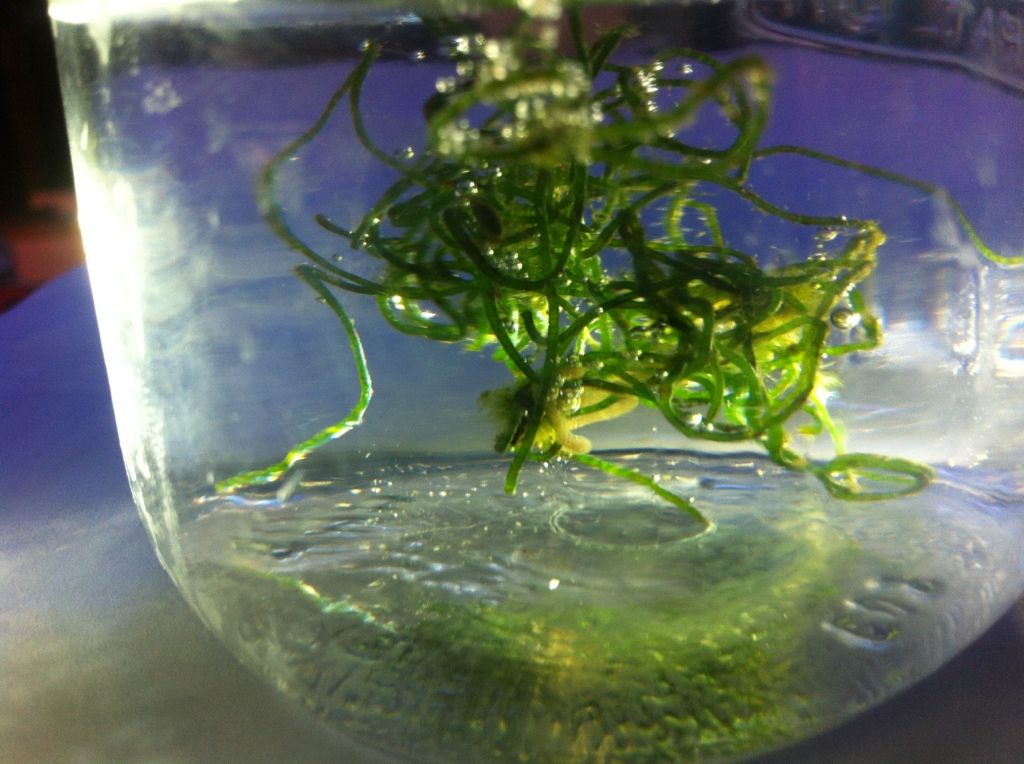 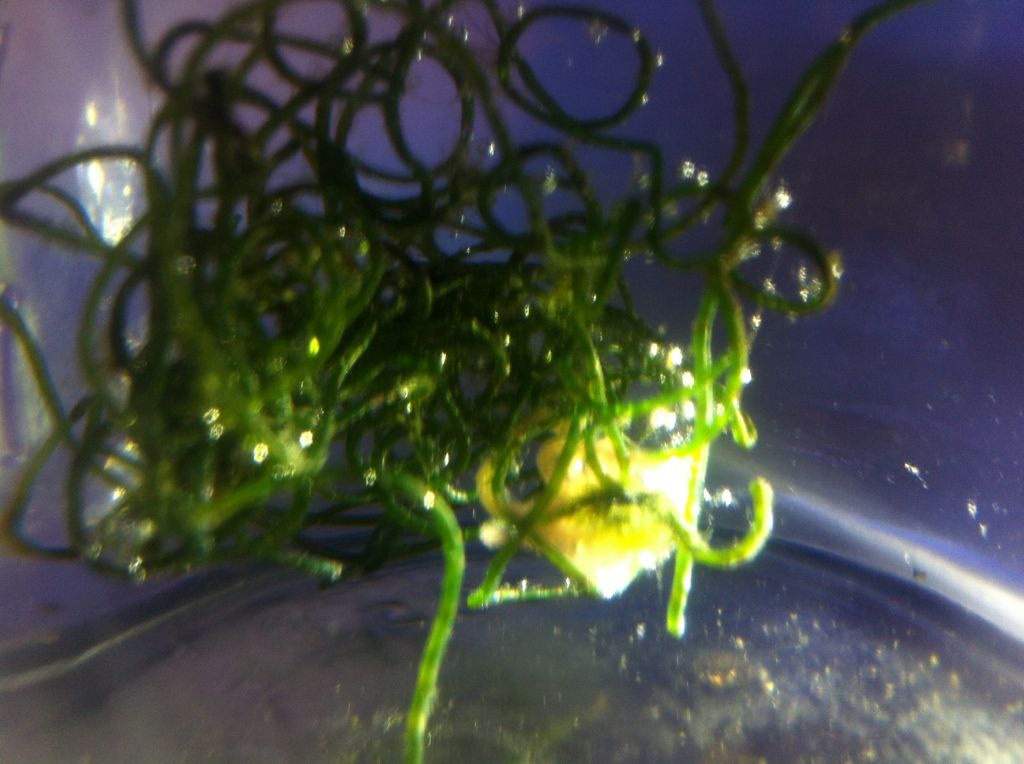 When I first saw these I wasn't sure if they were eggs or chaeto with the chloroplast sucked out (there are also Elysia sp. sea slugs in the basket). Then I saw another egg string yesterday and began to think that they were indeed eggs. Second egg mass from 3-20-2013: 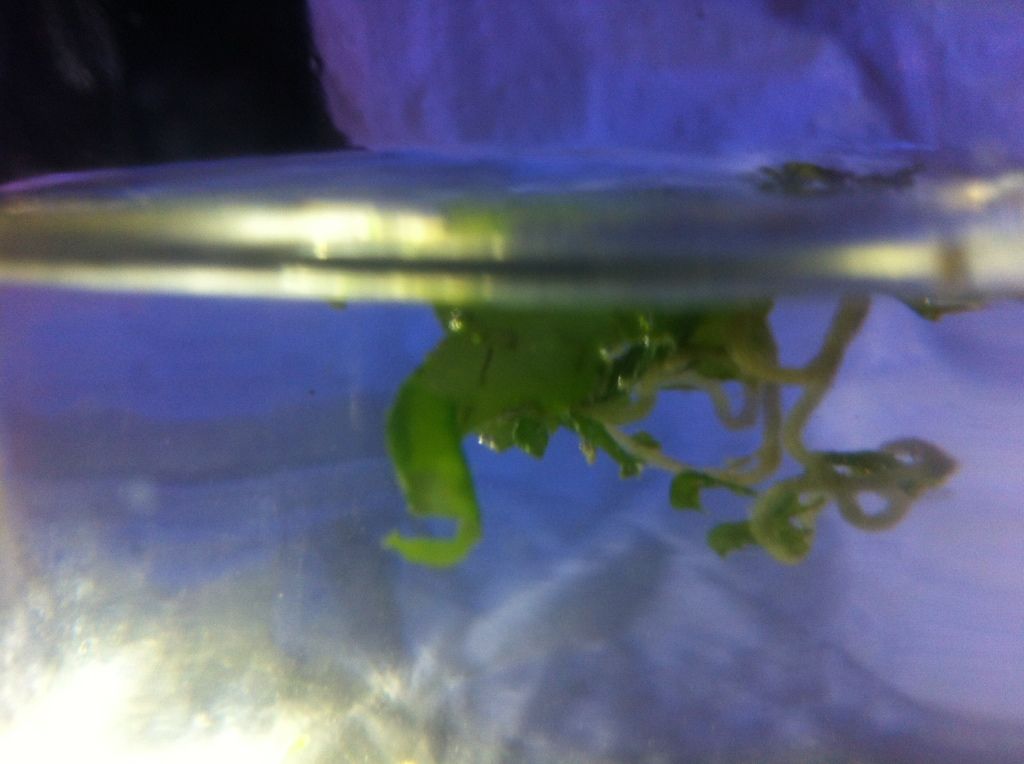 I took them out and looked at them under the scope: These are from the first egg string that will likely hatch tomorrow, Saturday or Sunday: 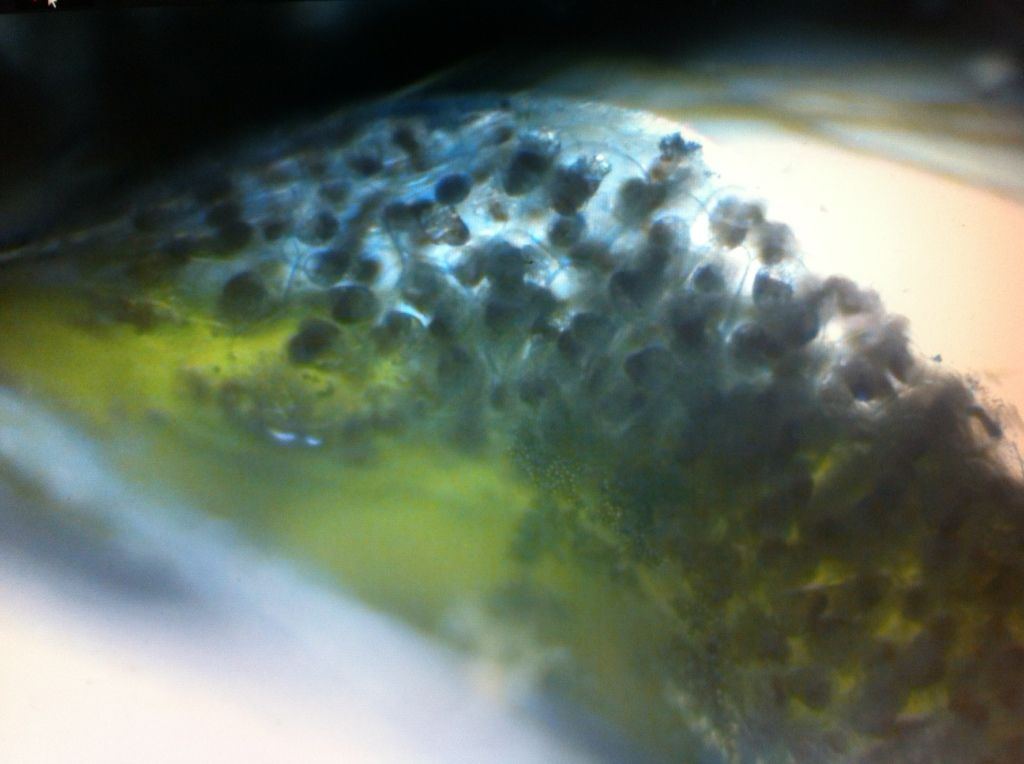 Second egg string: 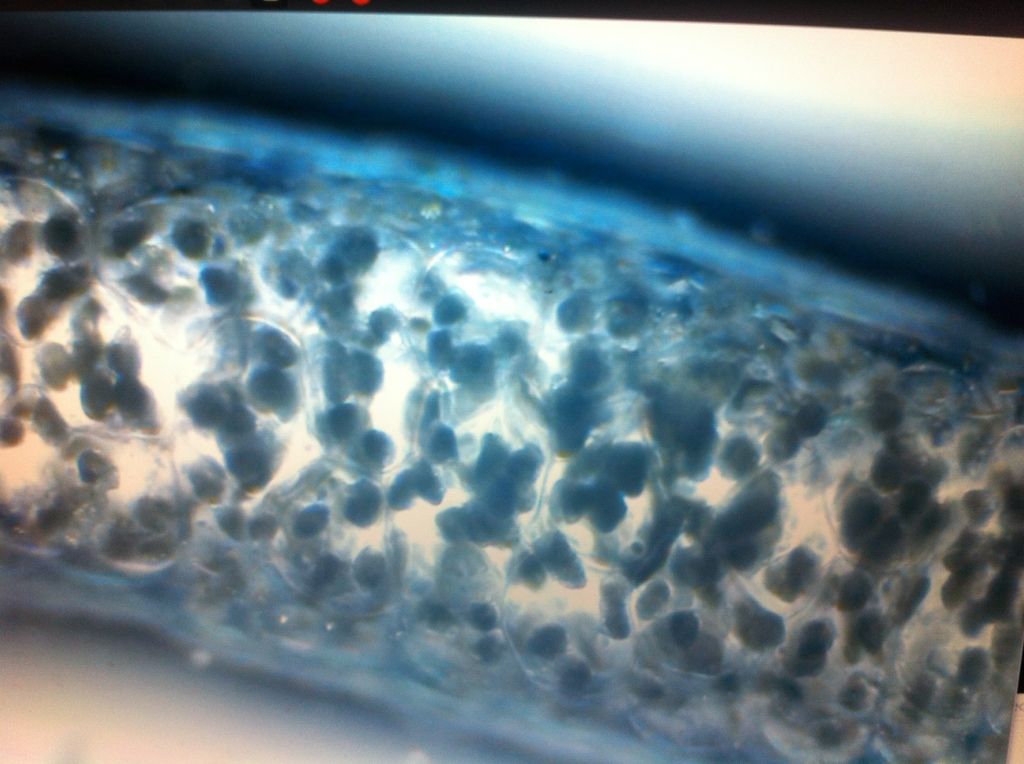 I took a video too but my computer freaked out (it barely functions) so I will have to try again. There seem to be multiple eggs in each capsule and they all move around A LOT so in the video you can see them just scooting around in the little capsules
|
|
|
 Re: Breeding Journal, Species: Bursatella leachii (Blue Dot Sea Hare)
Saturday, March 23, 2013 6:50 PM
Re: Breeding Journal, Species: Bursatella leachii (Blue Dot Sea Hare)
Saturday, March 23, 2013 6:50 PM
( permalink)
Here are the adults chowing on a spirulina and kelp algae tab. I am glad to see them eating them so happily. 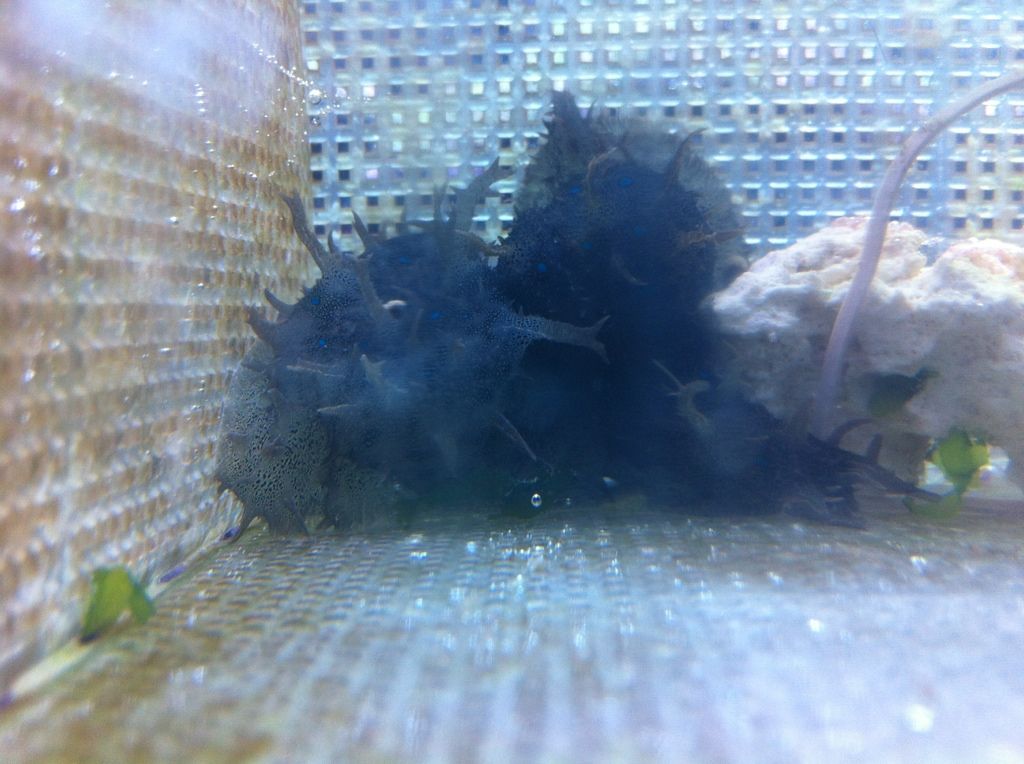 Sorry they sort of look just like a big blob...but that's also sort of just what they are  This morning I took the egg strings out since I thought they were looking sort of bad. I put them in this square 500mL container that I had cut the top portion off of and clamped into a juvie grow out tank to keep them warm until I could take a peek at them under the microscope. Then about mid afternoon I looked and there were things floating around! There was a hatch sometime during the day, perhaps all day, which may have also been why the string was looking different. 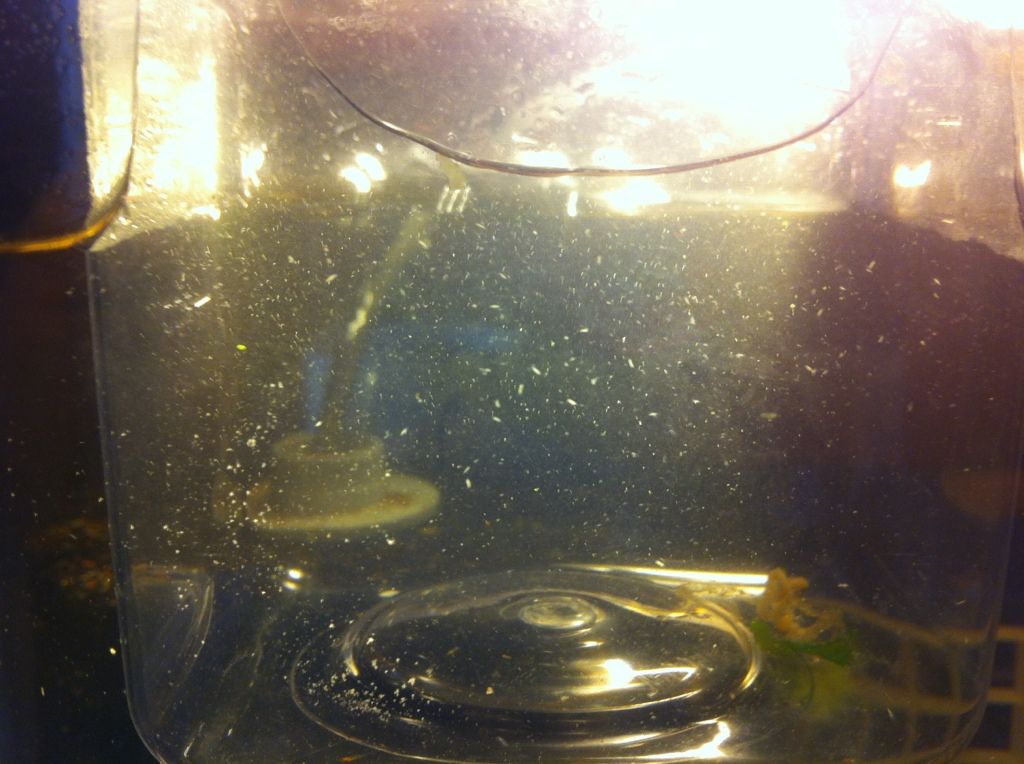 The small small dots are them. The larger one are pods that got stuck between the container and the glass of the tank. These guys look about the size of rotifers. I tried to put some in ethanol so they would stay still...and then all you could see was the shell. 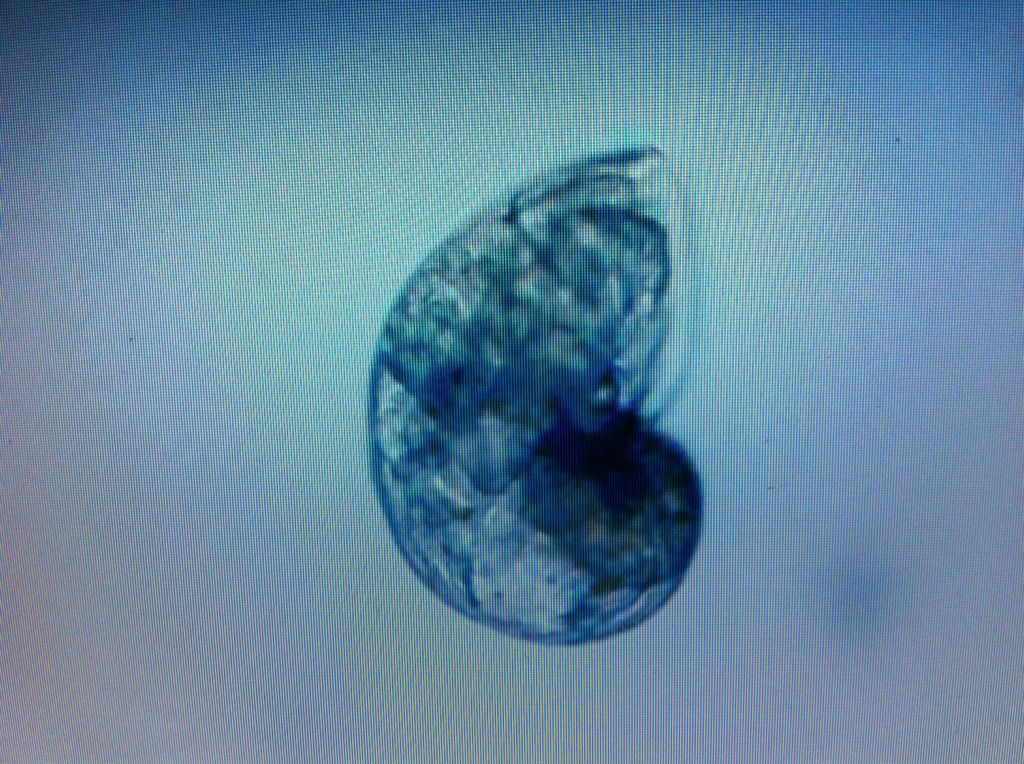 Here are some pics of the veligers in just water: 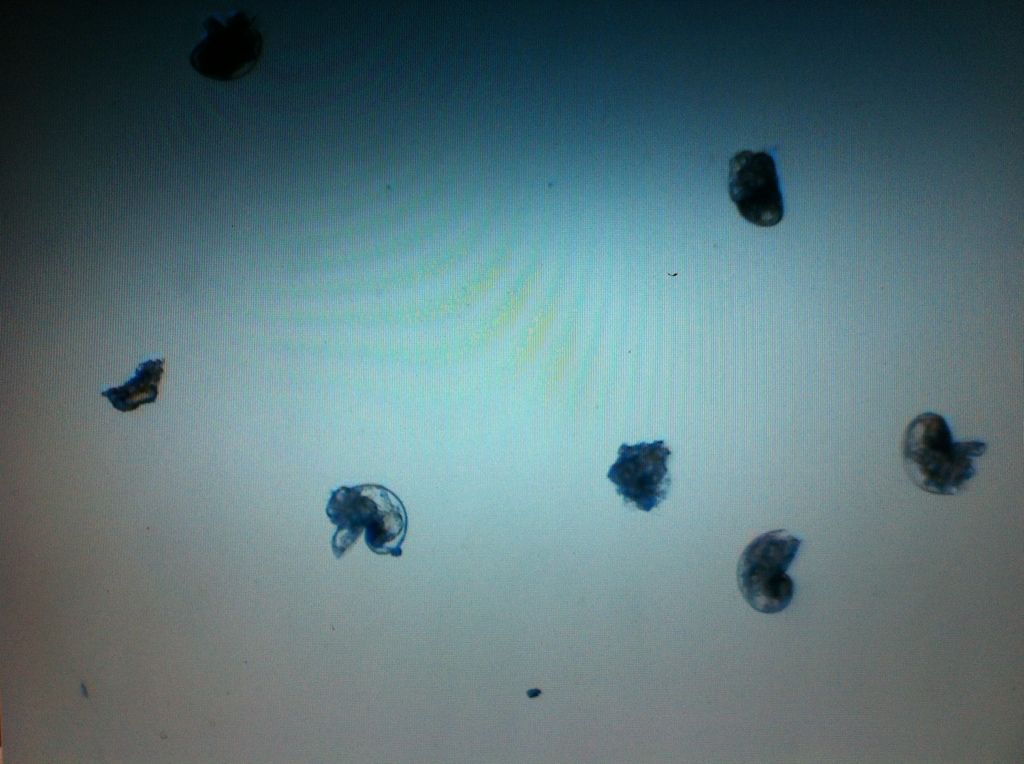 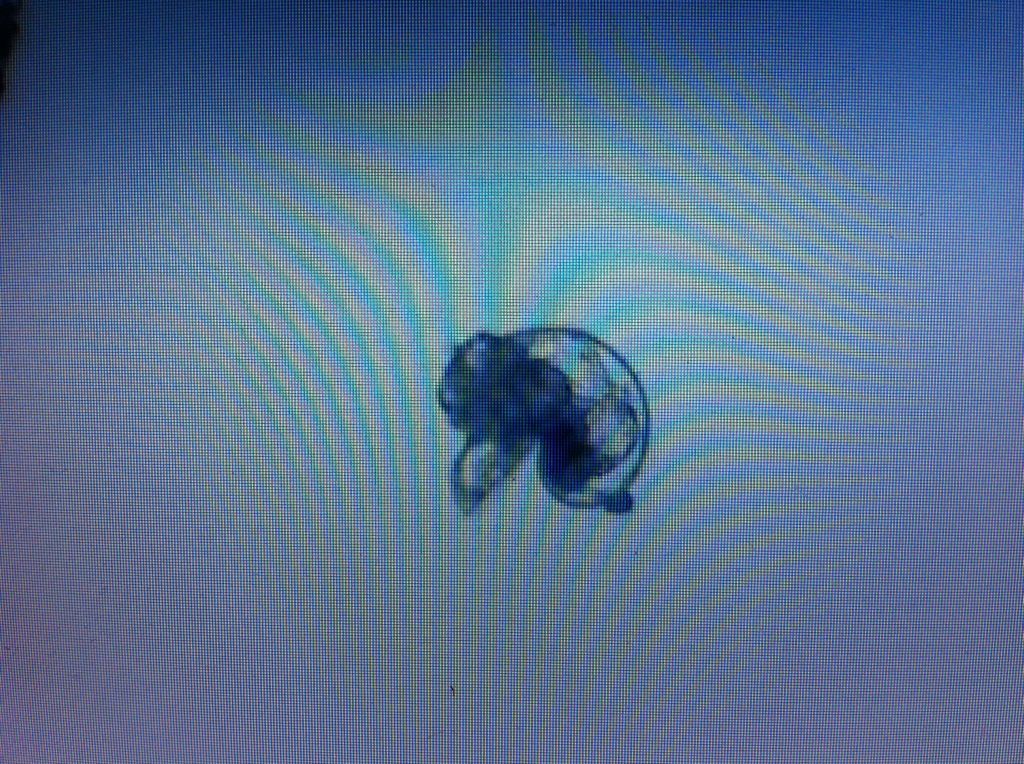 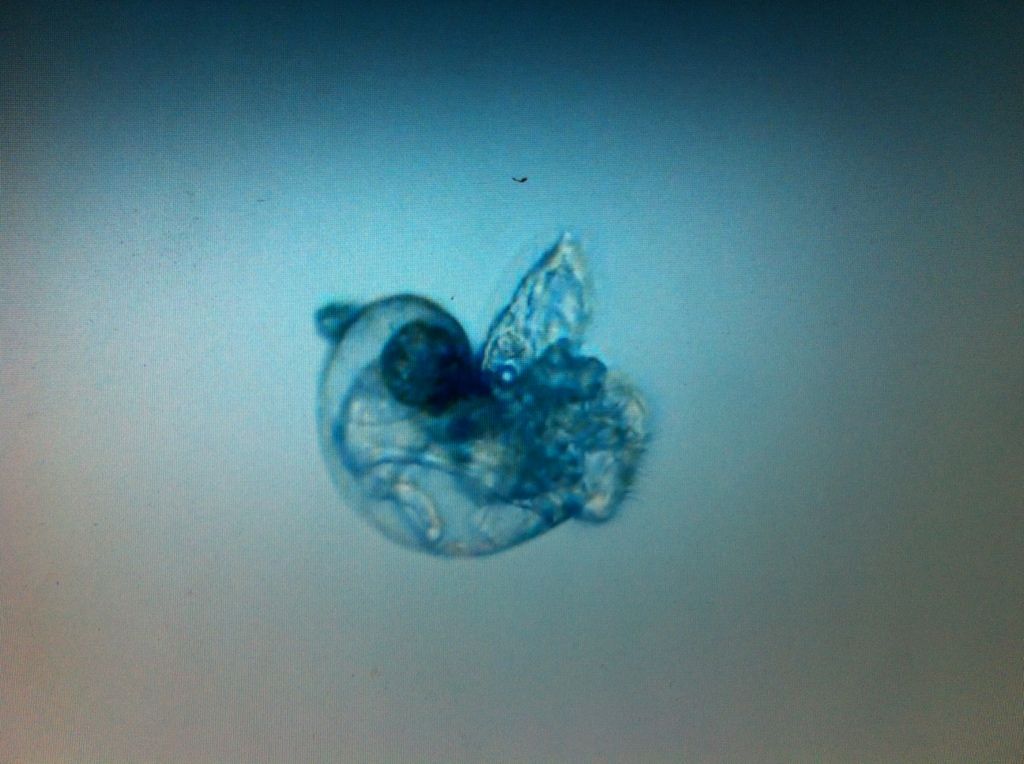 About half of them seem to have hatched so far. I have read that first food is phyto and the paper I read used T-Iso. Unfortunately, I don't currently have T-iso so I am going to try tetraselmis, chaetoceros and nanno for now. Maybe in future egg strings I will have T-iso handy. I put in 2mL of dense tetraselmis, 2mL of not so dense C.gracilis (I just split them so I wasn't exactly prepared), and 2mL of nanno. I only put in a small amount right now because the total volume they are in right now is less than 400mL. I will have to read the paper more closely to determine ideal phyto densities. Next thing to consider will be settlement cues. Blue-green algaes are what I have read Microcoleus lyngbyaceous, Schizothrix calcicola, and Porphyrosiphon notarisii are ideal. However, I have access to none of those. Paige (1988) also stated that "competent larvae of B.leachii plei preferentially settle and metamorphose on substrates that comprise a portion of the adult diet." Their adults were fed blue-green algaes. I wonder if adults fed other algaes will allow the veligers to settle on the algaes fed, or if it will just be blue-greens, and specific ones at that. Anyone have any thoughts or experience to share?
|
|
|
 Re: Breeding Journal, Species: Bursatella leachii (Blue Dot Sea Hare)
Monday, March 25, 2013 10:37 AM
Re: Breeding Journal, Species: Bursatella leachii (Blue Dot Sea Hare)
Monday, March 25, 2013 10:37 AM
( permalink)
I have successfully managed to kill them in a day. I went to my local public university library and tracked down a paper titled "The laboratory culture of two aplysiids, Aplysia brasiliana Rang 1828 and Bursatella leachii plei (Rang 1828) (Gastropoda: Opisthobranchia) in artificial seawater." that, from reading other papers about Bursatella and other aplysiids, would describe the larval rearing in a bit more detail. I found the paper, and also found out that everything I did the first day was wrong  The adults have laid another egg string (3-24-2013) and this morning they seemed to be interacting more than I have ever seen before, so I am hoping I will get home from work to see another egg string somewhere in the basket. This next string I hope to do a few things different. Paige (1986) used 3L erlenmeyer flasks for larval rearing for several reasons...the flasks have a wide base to allow for the algae to grow nicely in them, the flasks have a skinny neck, and they can easily be covered with a bit of parafilm. Apparently to raise these larvae less surface area is better. The container I had used had quite a bit of surface area. Paige filled the flask to the top, and then covered it with parafilm...so essentially there was no surface area at all. The veligers of Bursatella and other slugs seem to easily become trapped at the surface and die (I did see some floaters in my container, so I can see the importance of eliminating that). Paige also continuously lit the larval flasks, whereas mine was on a 14/10 light schedule. The cultures were not aerated either...which sounds like crazy talk to me, but the next attempt I am just going to try to mimic what has worked. He used T-iso, which I plan to order this week. I wonder if because the cultures are not aerated and have no water movement if using a motile algae is more crucial then? The stocking density was one veliger per 10mL which I thought I would have difficulty acheiving with my limited space...but then I realized that they were doing their larval rearing at room temperature (and not a warm room!) so I may be able to find more locations to put flasks and other culture containers if I need, as long as they all get some light. I have a couple flasks, a 2L vase looking thing and 2L bottles around that I may try to utilize. It would be awesome if 2L bottles worked. It sounded like settlement was attempted in 100mL "bowls" so I think large petri dishes may work alright for that step (if I ever get that far). Attempt #1: Complete failure Attempt #2 will likely begin at the end of this week 
|
|
|
 Re: Breeding Journal, Species: Bursatella leachii (Blue Dot Sea Hare)
Monday, March 25, 2013 10:51 PM
Re: Breeding Journal, Species: Bursatella leachii (Blue Dot Sea Hare)
Monday, March 25, 2013 10:51 PM
( permalink)
Another egg string was laid today. I may remove them as I find them and put them in mesh containers or something so I can keep track of what string was laid on what day and have a better idea of when they will hatch. My first hatch I am not positive came from the first string of eggs. It could have been the second. It seems like my tank has been at 82 this week so perhaps I missed the hatch of the first string and got the second string. Not sure.
|
|
|
 Re: Breeding Journal, Species: Bursatella leachii (Blue Dot Sea Hare)
Sunday, March 31, 2013 9:26 PM
Re: Breeding Journal, Species: Bursatella leachii (Blue Dot Sea Hare)
Sunday, March 31, 2013 9:26 PM
( permalink)
A few days ago I took the egg strings out (3 of them) and pu them in a 500mL container at room temp. I changed out the water every couple days. Today the oldest (at least I am assuming its the oldest string) started to hatch about mid afternoon. I poured out the veligers into a 1L flask, refilled the egg container and repeated that until the veligers were mostly in the larval flask (and I also accidentally dumped the older egg string into the larval flask. Not ideal but could be worse). I was aiming for about 10,000 cells/mL of algal cells, but I have way more veligers than would be ideal so I ended up putting enough tetraselmis in to tint a very light green. I also put in a very small amount if isochrysis but am unable to use it exclusively (or even for 50% of the food) because I just got a small starter on Saturday evening. I will probably just add a small amount every day, as much as I can, but it won't be very much. The remaining two egg strings are in the 500mL egg container with a small amount of tetraselmis also, just in case. Both containers are filled to the very top and have a section of a plastic sandwich bag rubberbanded over the top of them 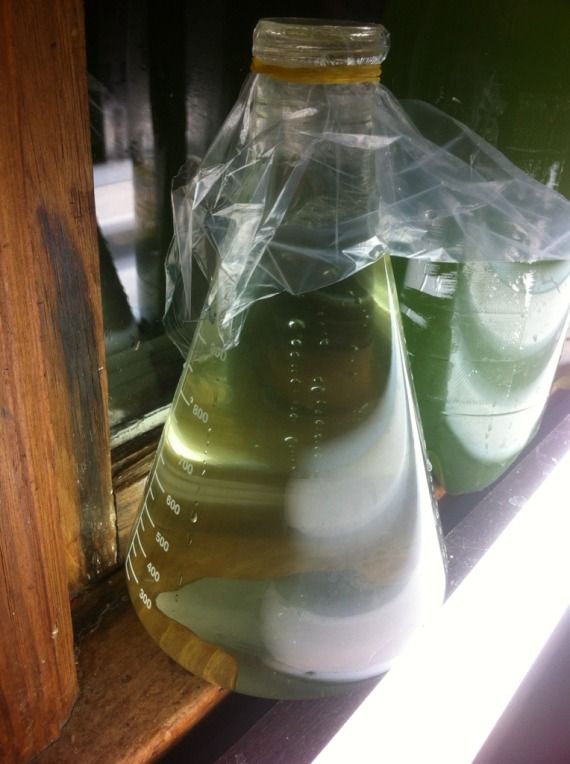 I couldn't keep a small air bubble from remaining under the plastic when I rubberbanded it on. Parafilm would likely work a bit better and tomorrow I will try to remember to get some. I also have some more Erlenmeyer flasks coming this week and hopefully I will have some veligers still alive and could split among the flasks to lower the stocking levels a bit. Although I will has two more strings hatching, so that may not actually happen. I have the flask and container in he culture station and will leave the light on during the night and rely on ambient light for the most part during the day.
|
|
|
 Re: Breeding Journal, Species: Bursatella leachii (Blue Dot Sea Hare)
Sunday, March 31, 2013 11:23 PM
Re: Breeding Journal, Species: Bursatella leachii (Blue Dot Sea Hare)
Sunday, March 31, 2013 11:23 PM
( permalink)
I came across this note on SeaSlugForum ( http://www.seaslugforum.net/find/22042) which you might find interesting (or maybe was already covered in the papers you were able to obtain): "The larvae are planktotrophic, which means they are free-swimming and need to feed on phytoplankton. Growth after hatching is rapid, with veligers reaching full size about 15 days after hatching, and by 19 days they are ready to metamorphose into crawling slugs. To settle out of the plankton and change into crawling slugs they need to find the cyanobacteria [blue-green algae] on which they feed [ Lyngbya majuscula ]. Growth after settling is rapid and within 15-20 days the larval shell is discarded and they are beginning to look like adult slugs, and can discharge a small cloud of ink if irritated" Sounds like the worst part of this project is going to be learning how to culture T-Iso  You can totally do this!
|
|
|
 Re: Breeding Journal, Species: Bursatella leachii (Blue Dot Sea Hare)
Sunday, March 31, 2013 11:38 PM
Re: Breeding Journal, Species: Bursatella leachii (Blue Dot Sea Hare)
Sunday, March 31, 2013 11:38 PM
( permalink)
That probably actually came from the 1986 Paige paper  I actually had to track that one down in person because it was not anywhere online. I have actually cultured t-iso before and didn't have too many problems...until I contaminated my f/2 with tetraselmis. I changed my sterilization protocol so that shouldn't happen again. I think the biggest issue I will have will be finding the right settlement algae (I say this after having killed the veligers of the first attempt after, what, 18 hours? Lol). The couple papers leave it open as to whether it is algae in the adult diet or a specific settlement algae. "Blue-green" algaes leaves a lot to try and finding ones that will work might be difficult. Or, if luck is on my side, one of the algae types I have growing in my various tanks will work. The adults were moved Friday from their breeder basket to a 30 gallon cube that has a lot of algae growing on the glass. Although I like having them in a larger tank and able to graze for whatever they want, I don't like that egg strings will be more difficult to find and it will also be more difficul to supplement their diet if need be. I am not sure if this move will be permanent.
|
|
|
 Re: Breeding Journal, Species: Bursatella leachii (Blue Dot Sea Hare)
Monday, April 1, 2013 8:59 PM
Re: Breeding Journal, Species: Bursatella leachii (Blue Dot Sea Hare)
Monday, April 1, 2013 8:59 PM
( permalink)
Today I got some parafilm. I took off the plastic bag I had over the flask and could see that even that little bubble that was trapped under the plastic was a problem. 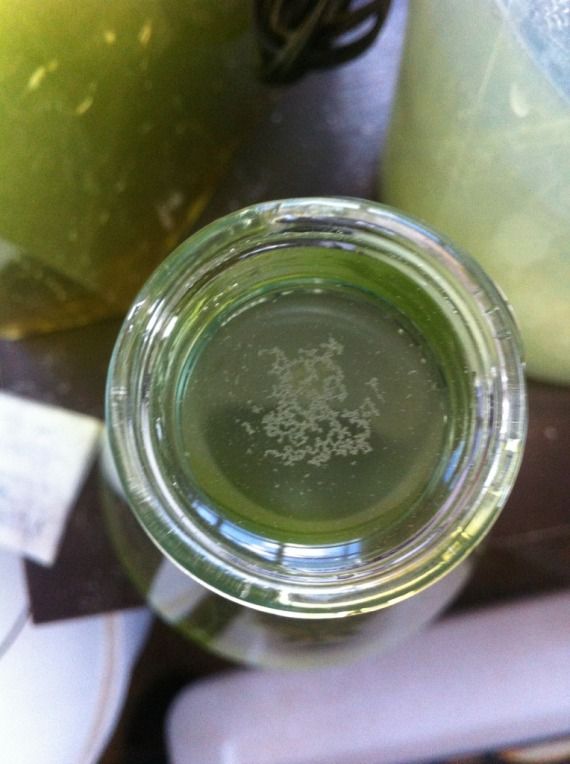 You can see many dead veligers trapped at the surface. I sucked them off the surface with an eye dropper. Then I added some more ASW and a small amount of tetraselmis until it was nearly overflowing and parafilmed the top. There is still a teeny teeny bubble, but it is probably as good as I will be able to get it. Once covered I swirled the flask a bit to get the tetraselmis that had settled and the small amount I added mixed and back in suspension.
|
|
|
 Re: Breeding Journal, Species: Bursatella leachii (Blue Dot Sea Hare)
Tuesday, April 2, 2013 10:05 PM
Re: Breeding Journal, Species: Bursatella leachii (Blue Dot Sea Hare)
Tuesday, April 2, 2013 10:05 PM
( permalink)
I am embarrassed to admit it, but I *may* have accidentally topped off the larval flask with vinegar instead of sterilized water. I would think that I would have smelled it when I did it (and I know I didn't smell vinegar) but today I went to add water to another culture and smelled vinegar just before I dumped the water in...then I realized I grabbed the vinegar jug. Oops. There is a chance I didn't do this, but....
In any case, there still seem to be veligers floating around, however there are far fewer in there already.
The other two egg strings still haven't hatched, and they remain at room temperature. Today I looked in the cube for egg strings and found two. Both were on the mag float and seemed to be at about the same development based on the color of the egg strings. I will peel them off and put them into a 500mL container and clamp that in the cube until they hatch.
My iso culture is slowly being increased, so hopefully the next hatch I will be able to do exclusively with that. And without the vinegar.
|
|
|
 Re: Breeding Journal, Species: Bursatella leachii (Blue Dot Sea Hare)
Thursday, April 4, 2013 9:07 AM
Re: Breeding Journal, Species: Bursatella leachii (Blue Dot Sea Hare)
Thursday, April 4, 2013 9:07 AM
( permalink)
The two egg strings at room temperature should have hatched, but never did. My guess is that lack of water movement caused them to die. They turned white and I am going to toss them. I need to pull the other two recently laid egg strings (noticed on 4-1) off the magfloat and put them in a hatching container before they hatch out in the tank. It's hard to decide if I should put an airline in the hatching container. On the one hand, the egg string will do better; on the other hand, once they hatch the bubbles fling the veligers out of the container or up onto the sides. I think the best tradeoff will be to bubble fresh egg strings, and to remove the airline closer to hatching, if I remember.
|
|
|
 Re: Breeding Journal, Species: Bursatella leachii (Blue Dot Sea Hare)
Sunday, April 7, 2013 3:47 PM
Re: Breeding Journal, Species: Bursatella leachii (Blue Dot Sea Hare)
Sunday, April 7, 2013 3:47 PM
( permalink)
A bit of bad news this morning. At least one of the blue dots took a wander into a power head. It is almost amazing that it squeezed its way in since the power head is tight to the glass and the inlet slits are on the back of the power head. In any case, one is definitely a goner. The other is currently missing and I wonder if it also went into the power head or died somewhere. My LFS has a least one blue dot sea hare in, so I may snag it since it is a smaller one and try to get another small one.
I had three egg strings that I pulled off the mag float. One hatched on 4-5-13 during the day. The other two were put in a container clamped in the tank with an airline. Today another egg string has started hatching.
The 4-5 egg string was split into two 1L flasks. Both were filled to the top and a small amount of T-Iso was added and the tops were parafilmed to eliminate as much surface area as possible. Each morning I add a couple mL of T-iso (I use a long eye dropper to remove some of the larval water since most seem to hang out at the surface). The egg string hatching today will be split into a 1L square plastic bottle and two 500mL plastic bottles and treated the same as the previous hatch with the exception that one 500mL bottle will be fed tetraselmis and the other 500mL bottle with get c. gracilis (diatom, non motile). The 1L will get T-iso.
If I get another hatch, or this current one seems bigger, I will also try a nanno trial. I am thinking with the non-motile algaes I will need to invert/mix the container once or twice a day.
I found one last egg string in the tank also, and can't say when it was laid or when it will hatch. I will move it to the hatching container once the current ones are done hatching.
|
|
|
 Re: Breeding Journal, Species: Bursatella leachii (Blue Dot Sea Hare)
Tuesday, April 9, 2013 12:48 PM
Re: Breeding Journal, Species: Bursatella leachii (Blue Dot Sea Hare)
Tuesday, April 9, 2013 12:48 PM
( permalink)
So, I have been dealing with a near continuous hatch-out from multiple egg strings since Sunday mid-day, and it is still going strong. In the morning I dump the veligers that hatched during the night into a larval container, add some water, swish it in the hatching container, dump into larval container, add water to the hatching container and leave it until the afternoon (repeat process), then leave it until bed (repeat process). Monday morning there were so many I divided them into multiple 500mL containers. I have decided that I prefer my "square" containers over the glass erlenmeyer flasks. These are what they look like: 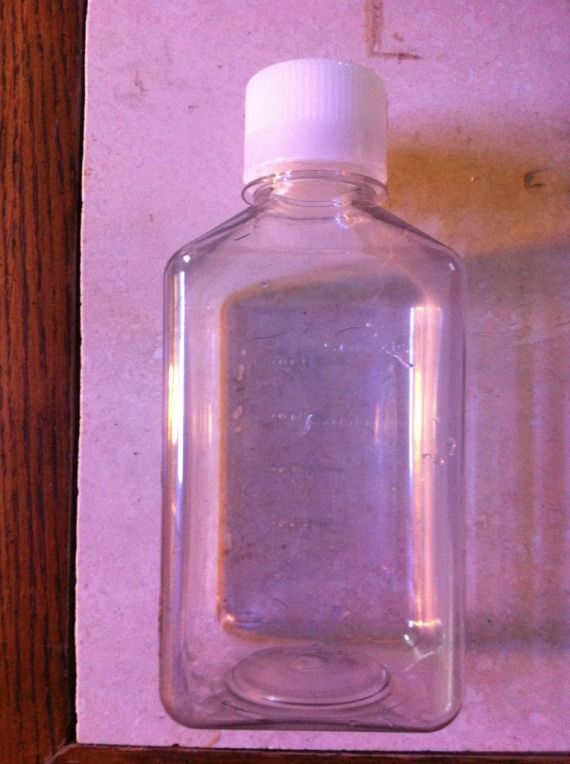 I mainly have 500mL ones, but every once in a while I get super lucky and find an empty 1L one at my work (it's happened twice...I need more!) The reason I like them is because the tops seem to hold the parafilm in place much better and don't allow small amounts of liquid to dribble down the outside of the container like the flasks. The flasks seem to slowly siphon out small amounts of water and then I end up with a water level about 1/2 cm under the parafilm top and a bunch of dead veligers stuck on the surface. I don't seem to have this problem with the plastic containers. The other perk to them is that even if they did dribble water out, most of the veligers don't hang around in the "neck" of the square bottles the way they do in the flasks. Because there is a sort of "step" to get to that neck area, the veligers tend to congregate there instead, keeping them safely away from the surface. I have been inverting all the containers at least 1x a day, usually 2x to make sure everything stays suspended. I have noticed that it is key to not add too much phyto when you first make the larval container. The phyto seem to grow faster than the veligers eat it and the flask will get darker and darker...I have tried to be more careful with this than I was in Attempt #2. The water will be changed out this weekend if they make it that long, which I am sure will be a stressful process for all involved. And since I have like 10 containers with these guys in them, and yet more to come, it will likely be a very time intensive process also. During the water change I may try to get densities down...but not sure how crucial that really is, and to be honest, I've pretty much run out of space to put these in my phyto station. I have started to put them on my kitchen window sills, so things are getting a bit out of hand. I have at least one 500mL bottle devoted to each of the types of live phyto I culture. I am hestitant to put anything other than T-Iso in since that one has proven to be tried and true, but I am also curious if other phytos will work. Most of the containers (including all of the "large" 1L containers--3 in total) have T-Iso. Nanno, Tet, and C. gracilis each have one 500mL and there is one 500mL that is a combination of T-Iso and Tet that was started this morning from the veligers that hatched overnight. And that's that so far.
|
|
|
 Re: Breeding Journal, Species: Bursatella leachii (Blue Dot Sea Hare)
Friday, April 12, 2013 3:28 PM
Re: Breeding Journal, Species: Bursatella leachii (Blue Dot Sea Hare)
Friday, April 12, 2013 3:28 PM
( permalink)
I found this little tidbit on the sea slug forum. Now, it is not about Bursatella, BUT the feeds may be quite applicable. http://www.seaslugforum.net/find/7028 It looks like Sylocheilus striatus hatches out smaller than B. leachii so if those little guys can eat certain phytos, then mine likely can too. Essentially it boils down to nanno gave the best survivorship over an eight day trial, and tetraselmis gave the best growth rates (very very closely followed by T-Iso). This makes me think that the best combinations to use could be T-Iso or Tet with Nanno. Currently I only have T-Iso and Tet combinations, and I feel I should make a brief note that the nanno bottle I had looked like the majority of the veligers were still cruising around... I still have some veligers hatching out (last night was a pretty big hatch) and it looks like my last egg string is about to hatch today or tomorrow. With those larvae I will do some Nanno+Tet or Nanno+Iso bottles. Water changes need to start this weekend and considering there are 15 bottles, I don't anticipate it being a jolly good time, and I also haven't decided on what sort of contraption to make/use. The Paige paper has a diagram of a nifty little siphon/mesh/graduated cylinder thing that greatly limits the exposure to air but I don't know how closely I will be able to replicate that. If I come up with something that works I will post pics. One of the 1-L flasks from the 4-5-13 hatch seeped out more water than I realized and had surface area that the veligers were exposed to. A significant number of the veligers became trapped and died. I suctioned them off this morning, topped the flask off, and resealed it. There aren't that many left in that particular flask, although I will get a better idea of just how many during the water change, I hope. I will be setting up a sea hare veliger station specifically for these tonight since at this point they are hogging all the space for my cultures.
|
|
|
 Re: Breeding Journal, Species: Bursatella leachii (Blue Dot Sea Hare)
Saturday, April 13, 2013 1:01 PM
Re: Breeding Journal, Species: Bursatella leachii (Blue Dot Sea Hare)
Saturday, April 13, 2013 1:01 PM
( permalink)
Here is the "larval station"  It consists of 18 500mL bottles, and 4 1L containers. The last of the veligers should hatch today and fill up one last 500mL bottle, which is good, because I have pretty much run out. If the adults were still alive I would let some of these go, but since this may be the last of be egg strings I will try to raise every last veliger... The oldest are on day 8. In 10 days or so (given they live that long) they will be ready to settle. So now I need to begin to prepare for that. As I mentioned earlier, ideal settlement substrates are Microcoleus lyngbyaceous (Lyngbya majuscula), Schizothrix calcicola, and Porphyrosiphon notarisii. This is for B. leachii plei and these substrates had "significant" settlement, meaning greater than 50%. I am not certain mine were B. leachii plei, or if they were a different subspecies, and I am not certain how much of a difference that will make. The paper also mentions that the settlement substrates are foods preferentially eaten by the adults. Other foods eaten/preferred also include oscillatoria submembranacea, Spirulina subsalsa, Scytonema hofmannii, Anabaena sp., and Calothrix crustacea. When they are competent to settle, I will try the algae in the tank they were in, species unknown, as the adult diet consisted of this. I am also considering ordering Spirulina major, which isn't the exact species from the paper, but I wonder if its close enough? Carolina.com also has Lyngbya sp and Oscillatoria sp, but only freshwater varieties, unfortunately. Does anyone know of a budget friendly source for any of the settlement algae species? Anyone have any thoughts as to the possible suitability of other "blue green" algae? The S. major culture is cheap (although shipping isn't so much) so I am willing to try that, but I don't think I am prepared to drop hundreds of dollars on other cultures yet. I suppose I could order the spirulina, try it and other algae I have in my tanks, and if that doesn't work, consider sourcing other cultures. The veligers can delay settlement for 70+ days once competent, so I would have some time. I haven't quite figured out how I want to change the culture water. The only appropriate sized sieve I have is a bit too large (FAF sieve that is 4" wide). Ideally I would have one that is more narrow than the opening to my culture containers so I can backwash directly into the container. I have a vague idea bouncing around in my head, but I haven't made it yet.
|
|
|
 Re: Breeding Journal, Species: Bursatella leachii (Blue Dot Sea Hare)
Tuesday, April 16, 2013 11:40 AM
Re: Breeding Journal, Species: Bursatella leachii (Blue Dot Sea Hare)
Tuesday, April 16, 2013 11:40 AM
( permalink)
I have made a little mini-sieve that I can use to transfer veligers out the bottle, wash through the sieve and then invert the sieve (that fits into the bottle opening) and backwash the veligers into the bottle with new (aged) ASW. 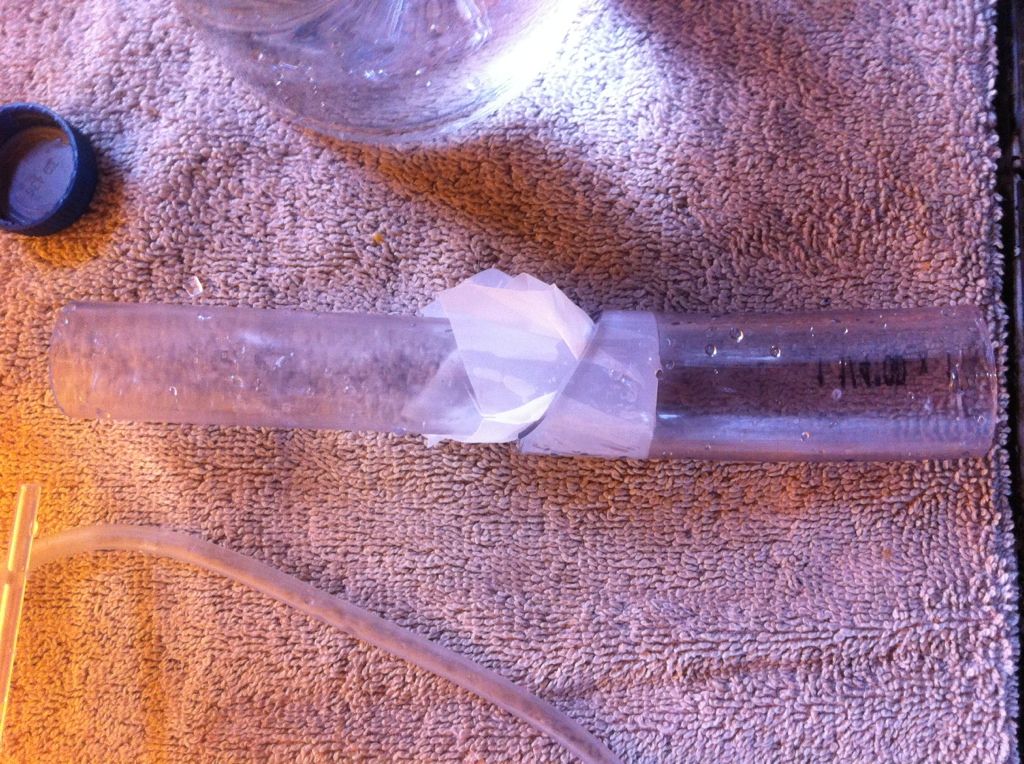 The left side is this clear rigid tube thing I found randomly on Saturday, the right side is flexible tubing that just barely fits over top of it. Unfortunately, the only size micron mesh I had available that wasn't too large was the 40uM. I have since ordered some 180uM that will hopefullly work better. Current issues with these....AIR BUBBLES. Ey. I have to top off the containers and replace the parafilm like 3 times a day to remove air bubbles. And I can't even venture a guess as to how many of these guys have become trapped and die in that little itty bitty surface area. The live phyto helps keep the water clean (and is obviously eaten also) but if there aren't a lot of veligers in the bottle then the phyto grows faster than it is eaten and I get a faster and faster accumulation of air bubbles at the parafilm. The worst cultures I have sieved out the veligers and diluted out the phyto (and sometimes combined bottles since there are very few veligers remaining in most of those containers). I have also ordered some cetyl alcohol (it is mentioned in some papers as the method used to keep veligers from becoming trapped at the surface) and look forward to giving that a try when it gets here. Another problem is that to make sure there is no bubble trapped when I put on new parafilm, I add just enough extra water to the container that it nearly spills over the edge, but the surface tension keeps it from doing so. Then I get the parafilm ready and put it on from one side to the other. This sort of pushes the water over the edge as the parafilm is completely put on. Sometimes the water will sort of siphon out a bit and later I will see like 300 crusty veligers stuck under the parafilm on the OUTSIDE of the bottle. This has become quite annoying and unfortunate. Perhaps, once again, the cetyl alcohol will help solve this problem. I do have one bottle that I have most of my hopes on. It was from the 4-7 to 4-8 hatch period (hatched out from about 9 PM on the 7th to 6am on the 8th). This bottle is PACKED with veligers, but in my case, that is good because they seem to be eating the phyto enough to keep it in check. I have not had to replace the parafilm on this bottle due to air bubbles once yet. I am hesitant to do a water change on it either because I don't want to mess up what's working! Here is the 500mL bottle with them in it. 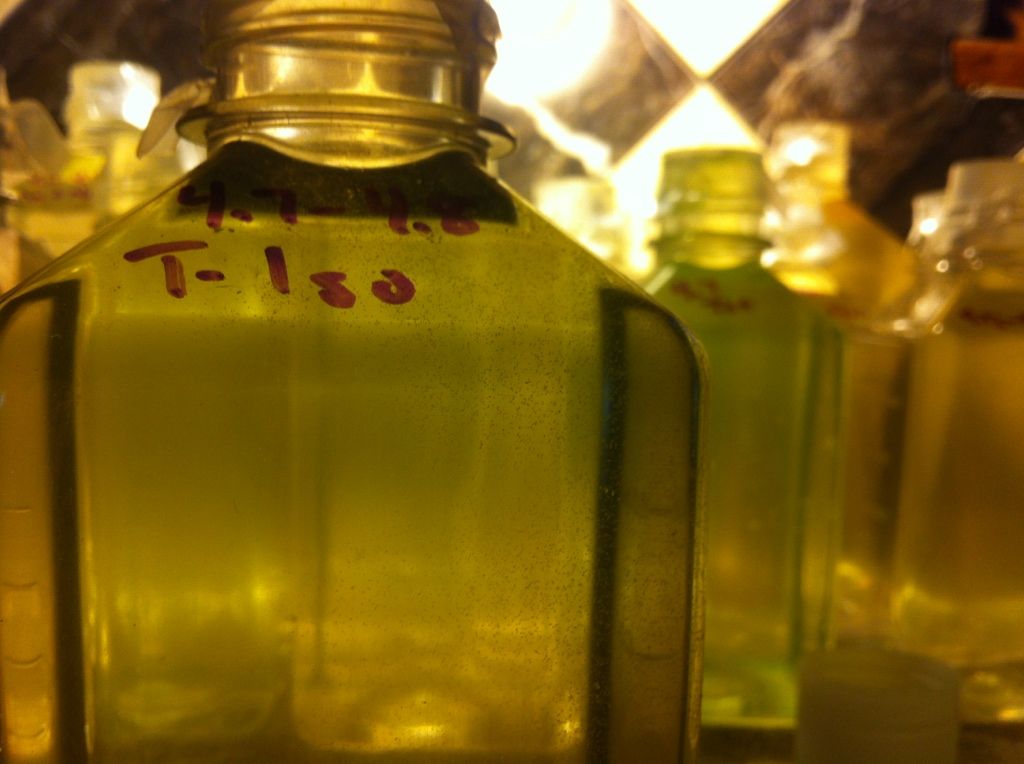 They are the teeny tiny dots, mostly on the right hand side of the bottle. Here is a video of them cruising around (click on it): 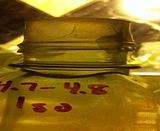 The bottle had been moved several minutes earlier so some of the motion is due to that, however, they really do seem to "cruise." They do seem bigger and darker to the eye than when first hatched, but that could also partly be my imagination. They are supposed to grow about 10uM per day, so they should be over 200uM by now. Spirulina has been ordered for the hopeful settlement attempts in a few weeks. I will probably use the same containers I have been using, just cut off the "neck" and "shoulders" of the bottles so they are more like dishes/bowls. I figure I will likely need the access to all parts of the container that I wouldn't have if I left the bottles intact. The cetyl alcohol will also come in to play at this step as parafilm is unlikely to work to keep them off the surface. (An interesting side note...I had often seen the full grown adults "walking" on the surface of the tank water until they bumped into the glass or rock and could "crawl" off the surface. So perhaps the surface can even be an issue for the adults.) Broodstock updates: I haven't yet purchased any replacement adults. I am thinking about setting up a little biocube tank I have sitting in my basement mainly for these sorts of animals. This tank would be ideal since I could keep the powerheads behind the scenes and wouldn't need to worry about them being sucked into another powerhead. I will decide this week what I want to do....I would love to keep working with these until I actually get some settlement...but we shall see. I have also been toying with some other ways to do the larval culture. This parafilm (cetyl alcohol) thing is...tedious. And the number of veligers that becomed trapped is incredibly high. So I am playing with the idea of creating a small benchtop roller similar to ones we use in the lab for tissue culture. I am trying to source crucial components now to see if it is even feasible (I have no intention of purchasing one to the tune of $800+). If it can be done relatively easily, and if it works (it doesn't have to look pretty!)...well, then it would be the answer to all of my problems! That fact alone makes me think I won't be able to do it lol
|
|
|
 Re: Breeding Journal, Species: Bursatella leachii (Blue Dot Sea Hare)
Tuesday, April 16, 2013 9:30 PM
Re: Breeding Journal, Species: Bursatella leachii (Blue Dot Sea Hare)
Tuesday, April 16, 2013 9:30 PM
( permalink)
Shannon, your journal is incredibly interesting, good luck!
Don't let fear and common sense stop you! =]
|
|
|
 Re: Breeding Journal, Species: Bursatella leachii (Blue Dot Sea Hare)
Wednesday, April 17, 2013 8:52 AM
Re: Breeding Journal, Species: Bursatella leachii (Blue Dot Sea Hare)
Wednesday, April 17, 2013 8:52 AM
( permalink)
 Originally Posted by EasterEggs
Shannon, your journal is incredibly interesting, good luck!
Thanks! It's interesting working with these things. It's an exercise in problem solving more than anything. The veligers themselves seem rather hardy and low maintanence, as long as you can give them exactly the right environment, which is no air. Easier said than done! So, yesterday I put this problem out to my lab coworkers (get a bunch of lab nerds together and give them a problem...no matter their specialty, you WILL get some ideas tossed your way  ). I need to create an environment where there is no exposure to air but air can escape as needed to prevent air bubble accumulation OR I need to create some sort of benchtop roller for under $50 that would keep a culture with a very small amount of air in continuous movement so as to not allow veligers to become trapped at the surface. After we worked through the most elaborate motor, gear, roller theoritical apparatus construction and poked around the lab for possible roller items and argued over torque and RPMs and rolling container sizes...someone finally said "why don't you just put some oil on top?" Duh. Why don't I just put some oil on top? In theory, this should work similar to cetyl alcohol (which I ordered but may not be here until next week and considering how few veligers there are in the bottles with the biggest bubble problems, I doubt I would have anything to work with next week by the time it gets here...). The oil, I hope, is "slippery" enough on the water that the veligers won't get trapped in the oil (fingers crossed!) and the cool thing about the oil is that it allows the container to sort of "burp" out the air created by the phytoplankton. I took my 10 worst containers, pulled some excess water out (just a couple mLs) and then added a thin layer of oil. I can (hopefully) suck the oil off with a pipet when needed. So my temporary solution to this problem (at least until the cetyl alcohol gets here) MAY be canola oil  The test containers had the lowest numbers of veligers, so if this fails miserably, it won't be too devastating. Also...I had to take my "best" bottle (shown in the pic and video a couple posts up) and open it up to put in some more phyto...I hope I don't get home to a big bubble and dead veligers! It was parafilmed instead of oiled since I don't trust the oil solution 100% yet. The Spirulina should arrive today which should give me enough time to a) start a culture and have several bottles going two weeks from now when I need it, or b) start a culture, kill the culture, order more, and maybe have enough to use when I need it in a couple weeks 
|
|
|
 Re: Breeding Journal, Species: Bursatella leachii (Blue Dot Sea Hare)
Wednesday, April 17, 2013 8:55 AM
Re: Breeding Journal, Species: Bursatella leachii (Blue Dot Sea Hare)
Wednesday, April 17, 2013 8:55 AM
( permalink)
Just another note...I still may very well try to make the benchtop roller. We came up with some good ideas and found most of what would be needed locally...That's nearly too tempting to pass up
|
|
|
 Re: Breeding Journal, Species: Bursatella leachii (Blue Dot Sea Hare)
Wednesday, April 17, 2013 10:24 AM
Re: Breeding Journal, Species: Bursatella leachii (Blue Dot Sea Hare)
Wednesday, April 17, 2013 10:24 AM
( permalink)
I am thinking you could add some micron mesh to hold the veligers down in the water, and have the water surface above the mesh. What if you put mesh over the top of the containers and then squeezed a piece of vinyl tubing over the mouth/opening of the container? If the seal is tight enough it will hold water without leaking, and you could fill the container above the mouth and up into the vinyl tubing. The phytoplankton will still be able to go through so you can still feed. In fact you could even decant the jar doing a waterchange, or even just slowly pump fresh water into the top letting it overflow to do a waterchange like that without exposing them to air.
Don't let fear and common sense stop you! =]
|
|
|
|